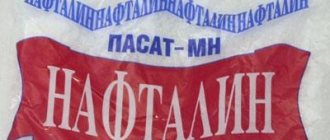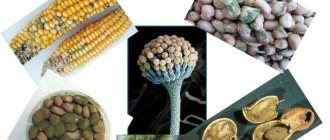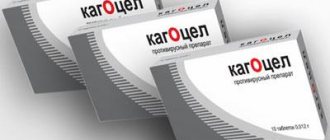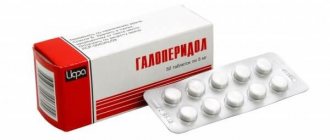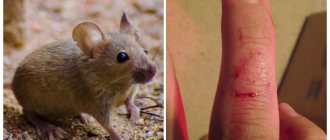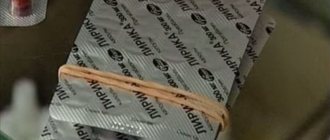Many people believe that infants are not at risk of poisoning - that’s why they are “infants.” Who better than an emergency doctor should know the value of such a misconception! If the baby is already able to move independently, it is sometimes difficult for adults to even imagine how quickly the young pioneer masters the living space around him. What is the main element of the development process? Of course, taste it! However, one should not think that a baby who has not yet learned to walk is completely immune from acute poisoning due to his helplessness. What if he gets sick, and his mother, who has not slept for many nights, mistakenly overdoses the medicine? Or a baby, with a sense of purpose worthy of the best application, crawls to the drawer with the first aid kit, opens it, and... We’ll talk about how to organize your life in such a way as to minimize the likelihood of such accidents, but for now we’ll tell you what to do , if trouble does happen.
Vitaly Zazovsky, ambulance doctor
How to diagnose acute poisoning
You can’t ask an infant what he ate and where he hurts, so if there is even the slightest suspicion of the possibility of poisoning (an open bottle of medicine was found, nail polish smeared on the dressing table, etc.), extreme care is required. In the case of infants, poisoning from ingested toxic substances is often detected based on a comparison of the symptoms of the disease and the fact that the corresponding toxic drug has disappeared. Symptoms of poisoning, of course, depend on the substance that caused it and on how much of this substance entered the body. However, the most common signs are:
- nausea, vomiting, severe weakness, abdominal pain, dizziness, allergic skin rashes (in case of poisoning with antipyretics and antibiotics, household chemicals);
- drowsiness, dizziness, lethargy, apathy, weakness (in case of poisoning with sedatives and hypnotics, alcohol);
- attacks of psychomotor agitation, muscle twitching, anxiety, lack of coordination, hallucinations, convulsions (characteristic of poisoning with antidepressants and other psychotropic drugs, anti-tuberculosis drugs - isoniazid, or tubazid; plant alkaloids, such as atropine, ephedrine, etc., gasoline and other petroleum derivatives, acetone, insecticides);
- vomiting mixed with blood, salivation, sharp pain in the throat, visible swelling and/or white plaque in the mouth, red urine (poisoning with caustic acids and bases: vinegar essence, ammonia, etc.).
What should you do if you suspect acute poisoning?
1. Call an ambulance immediately. 2. Before the doctor arrives, if the child has not drunk any acid (for example, acetic acid) or a caustic base (for example, caustic soda or a detergent based on it), he should be given as much water as possible. The amount of washing liquid for children up to one year old is 1 l (up to 5 years old - 3-5 l). 3. Place the child face down on the lap of an adult sitting in a chair. The baby's head should be lower than the rest of the body, and the belly should be slightly pressed. In this position, an index finger wrapped in a clean handkerchief or piece of gauze is inserted into the child's throat to induce vomiting. 4. Give your child activated charcoal (at the rate of 1 tablet per 10 kg of body weight). 5. The remaining toxic substance or vomit, as well as packaging material, should be collected and sent with the child to the nearest hospital.
What not to do if you suspect acute poisoning
1. Do not waste time under any circumstances - call a doctor and start providing first aid. 2. It is unacceptable to give the child any antidotes, laxatives or medications (with the exception of activated charcoal) before the doctor arrives. 3. Do not give your child milk - unless the toxic substance is acid. Milk (a traditional “folk” remedy for poisoning) can aggravate an already serious situation by accelerating the transition of the toxic substance into the child’s blood. (In case of acid poisoning, on the contrary, you should give the victim as much milk as possible, adding a teaspoon of baking soda to it.) 4. Do not hide from the doctor and people providing emergency care the circumstances in which the poisoning occurred, the origin and amount of the toxic substance, which could enter the child's body.
How to prevent a critical situation
1. Store the children's first aid kit separately from the adult one, and both in a place completely out of reach of the child. 2. Be extremely careful when you have to give your child medicine. Pay special attention to:
- name of the drug;
- its expiration date;
- doctor's prescription (necessary dosage form, dosage, quantity and time of medication taken during the day).
3. Do not store toxic substances in a place accessible to a child (cosmetics and perfumes on the dressing table, detergents on the sink, vinegar on the bottom shelf of the kitchen table, acetone and kerosene on an open shelf, etc.).
That, in fact, is all the precautions.
One can only be surprised and grieve that not all parents and not always comply with them. Tags:
Intoxication or poisoning is the body’s reaction to toxic toxins that disrupt its normal functioning. In young children, the digestive organs are just beginning to form, and therefore toxic infection is much more severe and intense than in adults. Any poisoning is fraught with complications and at the slightest sign of intoxication you should consult a doctor
Symptoms of food poisoning in a child
Food poisoning is most often associated with poor personal hygiene. The infection is transmitted from dirty hands, unwashed fruits and vegetables, shared toys, and dishes.
The most common cause of poisoning in children is intestinal infections, such as dysentery, salmonellosis, escherichiosis and others. After bacteria enter the body, the release of toxins begins, intoxication develops, the symptoms of which are fever, headache, and weakness. The first symptoms of poisoning develop several hours (usually 4-6 hours) after ingestion of poor quality food. The main symptoms of food poisoning include:
Loose stools mixed with mucus and undigested food;
These symptoms are accompanied by an increase in temperature to 38° C or higher. The child becomes lethargic, weakness, headache, and loss of appetite appear. Losing large amounts of fluid through vomiting and diarrhea leads to dehydration, which is extremely dangerous in children.
A child with such symptoms should be seen by a doctor immediately. It is important to remember that fluid loss of about 10% of an infant's total weight before 1 year of age can be fatal.
The fluid lost by the child’s body must be replenished by giving plenty of fluids in the form of saline solutions (for example, Regidron), fruit juice, tea, and glucose solution.
In order to remove toxins from the child’s body, enterosorbents are used - drugs that absorb harmful substances that enter the intestines. These include Smecta, Enterosgel, Polyphepan, etc.
If the child is breastfed, it is necessary to temporarily stop feeding and give the child chilled boiled water. After the child’s condition normalizes, you can return to your normal feeding regimen.
If the child is bottle-fed, you need to pause for 8-12 hours, after which you feed the child with sour-milk formulas, you can add rice water. You can switch to other foods (vegetable and fruit purees, cereals, meat) on the third day after stool normalization.
In case of food poisoning in older children, it is also necessary to adhere to a gentle diet on the first day. Your child can be given rice porridge with water, kefir, crackers, mashed potatoes without milk, and vegetable soups. You need to eat in small portions and at certain intervals.
In case of chemical poisoning, symptoms depend on the effects of the toxins themselves and may include disorders of the nervous, respiratory and cardiovascular systems.
Poisoning from home-canned food can be especially dangerous, since botulinum bacteria can multiply in them, releasing dangerous botulinum toxin. This toxin has nerve paralytic properties. If medical care is delayed, the consequences can be fatal. Treatment of botulism is carried out in an infectious diseases hospital, where the child will be injected with anti-botulinum serum in the first hours after admission.
Treatment of victims of poisoning with poisonous mushrooms and plants is aimed at quickly removing the poison from the body before it has time to be absorbed into the blood. It is very important to provide first aid even before the doctor arrives. To do this, you need to rinse the stomach by giving the child up to 3 glasses of saline solution, and then press two fingers on the root of the tongue to induce vomiting.
Causes of intoxication
Components of animal origin are a favorable environment for the proliferation of E. coli and staphylococci.
Cheese, cottage cheese, and yoghurts, which are not subject to heat treatment before consumption, spoil especially quickly in summer. The following factors provoke poisoning with fermented milk products:
- lack of proper control in production,
- milk purchased on the market has not been thermally processed,
- catering staff had ulcers on their skin,
- improper storage and transportation of fermented milk products,
- milk from a sick cow,
- consumption of the product after the expiration date,
- improper production of kefir, cheese, mayonnaise at home.
Diseases of the digestive system contribute to the development of intestinal dysbiosis. As a result, microflora multiplies, which provokes symptoms of dairy product poisoning. Some people do not tolerate dairy products well. Other people have milk intolerance due to the lack of the enzyme lactase, which breaks down milk sugar.
Prevention of food poisoning in children
Prevention of food poisoning in a child consists of following basic rules of personal hygiene - washing hands before eating and after using the toilet. It is important to carefully process vegetables and fruits before eating. You should pay attention to the shelf life of products and immediately throw away spoiled ones.
In the warm season, it is better not to cook in advance, since after a few hours any dish contains a large number of bacteria and can become the culprit of the disease.
Children should not be allowed to pick mushrooms and berries on their own, but only do this under adult supervision. Children under 5 years of age should not be given food made from mushrooms – mince pies, pancakes, pizza, etc. The child’s body does not yet produce enough enzymes to digest such food.
Caution should be exercised when children bathe in bodies of water. Infectious agents, such as dysentery, can remain in water for a long time.
Another, even more serious, reason is the mother’s frivolous attitude towards the health of her own child, her inattention and reliance on the Russian “maybe”.
The one-year-old baby woke up early and climbed out of the crib. Mom dressed him and let him “free-graze”, and she went to bed to get some sleep.
You say: this can’t happen? Unfortunately, it can, like all other cases from personal medical practice.
The kid, left unattended, happily ran the kitchen, scattered cereal, spilled oil, and then climbed onto a chair and took out his grandmother’s clonidine from the shelf. An hour later, when the mother woke up, the baby was already asleep, clutching a bottle of pills in his fist.
A friend came to visit her mother, whom she had not seen for a long time. There is so much news that requires immediate discussion over a cup of coffee and a cigarette. But passive smoking is harmful to children. Therefore, they left him in the room, and they retired to the kitchen. It is unknown how long the smoke break lasted. Mom claims that it won’t be long. But the baby had enough time to take birth control pills out of the guest’s bag and feast on them.
A two-year-old girl was playing on the floor with toys and suddenly fell asleep on the floor. Mom carried her to the crib and went about her household chores, happy that the child was not in the way. After some time, the mother noticed that the girl’s sleep was restless, she was crying without waking up, making random movements with her limbs, as if fighting off someone.
The emergency doctor suspected drug poisoning, and a bottle of amitriptyline (used for depression) was found on the floor among the toys. The child's restless behavior was explained by the occurrence of hallucinations.
Mom poured “Antinakipin” into the kettle and left it overnight so that all the sediment dissolved. When early in the morning the baby demanded a legitimate bottle, the half-asleep mother diluted the milk formula with water from the ill-fated kettle and gave it to the child. She came to her senses only after noticing that the mixture in the bottle had curled up into flakes. And during this time the baby had already taken a sip of a hefty dose.
Thousands of similar examples can be given.
But there are other cases when the mother exceeds the dose of the medicine with her own hands or mistakenly gives the child another medicine.
Every family has a first aid kit with a set of the most necessary and seemingly harmless medicines. But are they so harmless?
The familiar drugs diphenhydramine, suprastin, pipolfen, in addition to allergic ones, have a calming and hypnotic effect, which makes them very popular with some parents.
Wanting the child to sleep longer on a weekend or holiday, the mother gives the baby diphenhydramine in an increased dose.
Contrary to the expected result, the child does not fall asleep and receives another tablet. After this, the child not only does not calm down, but, on the contrary, becomes agitated, does not find a place for himself in the crib, fights off someone invisible with his hands, squirms, and cries. His skin turned red and dry, his pupils dilated, his heart beat faster. And the culprit was an overdose of diphenhydramine.
The baby has a runny nose. He cannot breastfeed and sleeps poorly. The doctor prescribed vasoconstrictor nasal drops for the baby: naphthyzin, galazolin or sanorin. After the first procedure, the baby breathed freely through his nose, ate well and fell asleep peacefully. The satisfied mother began to instill drops in him before each feeding, and then again before putting him to bed. By evening, the child seemed to have been replaced: he became lethargic, drowsy, refused to eat and asked to go to bed. The skin became pale, cold, and sweating increased. Having measured the temperature, the mother was horrified: 34.7 C. So intensive treatment of a runny nose led to poisoning of the baby.
Increasingly, vasoconstrictor drops are produced in plastic bottles equipped with a dropper spout. This is done for the convenience of consumers: remove the cap, press on the pliable walls, drop the medicine into the nose, and no fuss with the pipette. This method is not suitable for small children, since by applying force, you can inject the medicine in a stream, significantly exceeding the dose. Use a regular pipette, putting in as many drops as the doctor prescribed.
Unfortunately, poisoning in children is not limited to drugs. In everyday life, we are surrounded by chemicals designed to improve and make our lives easier. How many troubles and misfortunes the vinegar essence, used in every family for home canning, has brought and will continue to bring to children! No country in the world produces acetic acid of such concentration for household purposes, but here, please drink, I don’t want it.
But the baby doesn’t know how to read, but he remembers well that yesterday, during a walk, dad poured him some delicious water from such a bottle.
In children under one year of age, motor activity and field of activity are limited to a crib or playpen. They cannot obtain and swallow medications or toxic substances on their own. Therefore, the cause of poisoning in children in the first year of life is the inattention and carelessness of parents, when, having mixed up the dishes, they give the child alcoholic drinks or other toxic substances instead of water; instead of nasal drops, eye drops with clonidine are instilled; following doctor's prescriptions, they exceed the dose of medications, and often treat the child on their own, without consulting a doctor, relying on their own knowledge or the advice of friends.
The baby’s ability to move independently increases the risk of accidents, including poisoning. There are fewer and fewer inaccessible places for a child, and more and more attractive-looking objects and substances. Is it possible to pass by a bottle with such beautiful multi-colored tablets? You need to get them out and try them immediately. Oh, and they are also in a sweet shell, real candies!
Add here the mother’s carelessness in everyday life, the carelessness of adults when storing medicines and chemicals, and the picture will be complete.
The fate of a child with acute poisoning often depends on the correct behavior of the mother or others. What should a mother do if her child has taken a drug or chemical?
If the fact of ingestion of a toxic substance is established, immediately call an ambulance, and before the brigade arrives, free the child’s mouth from tablets that he did not have time to swallow, try to rinse his mouth and give him a large amount of water (up to 200 ml) with two crushed tablets of activated carbon or other adsorbent, for example, polyphepan (1-2 teaspoons).
Do not give milk to your child, as some poisons are fat-soluble, and the fat contained in milk will speed up the absorption of the poison.
Try to collect and count the remaining tablets, estimate how many tablets the baby managed to swallow. It is clear to everyone that the larger the dose, the more severe the poisoning, the more serious the prognosis.
But you shouldn’t calm down if you’re missing “just one” tablet. Some medications have such a strong and rapid effect that even one tablet can lead to severe impairment of vital functions. Such drugs include nitroglycerin, chlorpromazine, digoxin, gemiton, clonidine, amitriptyline.
Never induce vomiting in a child if poisoning occurs with concentrated acid or caustic alkali, which causes burns to the mouth, pharynx and esophagus. A caustic substance, when passing in the opposite direction, will inevitably increase the area and depth of the burn, and may also enter the respiratory tract. Try to give your child water (1.5 - 2 glasses) to reduce the concentration of the caustic substance in the stomach.
The popular opinion that in case of acid poisoning one should drink alkaline drinks, and in case of alkali poisoning - weakly acidic solutions, is incorrect, since the carbon dioxide formed as a result of such a reaction causes overdistension of the stomach and deterioration of the child’s condition.
If poisoning occurs due to gas or fumes of a toxic substance, the child should be urgently removed from the gas-polluted room, freed from restrictive clothing, and cleared of mucus and vomit from the airways.
If a toxic substance gets into the eyes, it is necessary to rinse the eyes with a stream of warm water using a syringe (without a needle) or a rubber bulb for 5 minutes.
If a toxic substance gets on the skin, the child should be undressed and the skin should be thoroughly washed with warm running water and soap, first treating the contaminated areas and then the entire surface of the body.
Sometimes the fact that a child is taking medications or chemicals remains unknown to the mother or other adult family members, which significantly complicates diagnosis, leads to untimely provision of assistance, and worsens the prognosis.
An alarming moment that makes a mother think about poisoning is a change in the child’s behavior: usually active and cheerful, he suddenly becomes lethargic, drowsy, and falls asleep at inopportune times. The sleep is so deep and sound that it is impossible to wake him up. Or, conversely, in a dream, a child makes active movements, crawls on the bed, fights off someone with his arms and legs, cries, screams, without waking up. This behavior indicates hallucinations. Convulsions and loss of consciousness may occur.
Consider poisoning if.
- your baby has a runny nose, and you, sparing no medication, instill vasoconstrictor drops into his nose, and the child becomes lethargic, refuses to eat and asks to sleep;
- in the midst of complete health, the child’s condition suddenly worsens, consciousness is impaired, convulsions appear, and there are no signs of an acute inflammatory disease.
Call an ambulance and tell your doctor about your observations and suspicions. The sooner you do this, the better for the child.
Is there really nothing that can be done to protect children from exposure to toxic substances? It is possible and even necessary!
Prevention of poisoning is extremely simple and does not require any moral or material costs from parents.
Store cleaning agents and detergents, insect repellent aerosols, stain removers and solvents, and technical fluids indoors or in a locked cabinet.
Pouring potentially toxic substances into food containers is not permitted.
Nail polish remover, deodorants, and cosmetic lotions should be stored on a high shelf where a child cannot reach even from a chair.
Do not leave unfinished alcoholic drinks in glasses. While you are seeing off the guests, the children can continue the festive feast, following your example.
All of the above applies to a greater extent to children, whose poisoning is mainly accidental.
The parents of two-month-old twins who suffered acute poisoning, as a result of which one of the boys died, believe that the cause of the tragedy was milk formula. Experts, having not found toxins in baby food, are inclined to conclude that the cause of death was the water from the well with which this mixture was diluted
While experts are conducting the necessary examinations and studies to find out why the children were poisoned, their parents are sure - it’s baby food!
“My twins were hard for me,” sighs sadly 24-year-old Lina Drapak from the village of Aleksandrovka, Tomashpolsky district, Vinnytsia region, a pretty, thin blonde. — Due to severe toxicosis and high blood pressure during pregnancy, I had to periodically go to the hospital for conservation. It’s not for nothing that they say that carrying twins is more difficult than carrying one child. Our sons were born at eight months old as a result of caesarean section. Pashenka with a weight of 2100 grams, Sashenka - 2200 grams. Because the children were not gaining weight well, we were kept in the hospital for two more weeks after their birth. When my husband, Pavel, and I finally brought the kids home, we couldn’t be happier with our sons. They noticed that Sasha looks like me, and Pasha looks like dad. Having become a mother, I immediately fell in love with my sons so much that it seemed that no one and nothing could separate us! The very capricious, demanding Sashunya, who was always fed and changed first, and the calmer Pasha were equally dear.
“About midnight I fed the kids, and they immediately fell asleep sweetly,” the woman continues. “I also took a nap myself.” I woke up hearing the children crying. And not as usual, but restlessly, out loud. Sashunya was especially alarming. He shuddered, choking with tears, greedily opened his mouth, apparently trying to grab more air, and his face was an unnatural blue color. I took his temperature and it was over forty. She carried the baby a little in her arms, pressing her tummy to her. But nothing helped - the child continued to cry. I tried to feed him, but the baby spat out the pacifier. Thank God, at least Pashenka, having again swallowed a whole bottle of baby food, calmed down and fell asleep. I was so worried! And as luck would have it, I was alone at home - my husband had gone to Moldova to visit his seriously ill father.
At six o'clock in the morning, Lina called the nurse and her friend, Aunt Olya, from her neighbors, who helped look after the children. Both - the doctor and the woman who raised her own children and grandchildren - suspected that the child had been poisoned by something. Soon both babies were hospitalized at the regional hospital. Doctors assessed the condition of one of them as critical.
“In the Tomashpolsky district hospital, the children were immediately provided with medical care,” notes Anatoly Starodub, head of the intensive care unit of the Vinnytsia Regional Children’s Clinical Hospital. “They underwent gastric lavage and prescribed the necessary therapy. The heavier baby was connected to a ventilator because he had pronounced tissue hypoxia, that is, an acute lack of oxygen, usually occurring under the influence of toxic substances. Alas, oxygen was not absorbed by the tissues, and blood microcirculation was disrupted. It was not possible to save the baby. But the doctors managed to stabilize the condition of another child, who also turned blue, suffering from hypoxia, by seven o’clock in the evening. The child regained consciousness, his skin turned pink. The next day, the baby was still lethargic and refused to eat, so, accompanied by our doctor, he was hospitalized at the regional children's hospital. There the boy's condition quickly returned to normal. After several days of treatment in intensive care, the child was transferred to the early childhood department.
Based on the symptoms of the disease and its course, we cannot exclude poisoning from baby food. But in order to confirm this, appropriate examinations should be carried out.
Treatment
Treatment should be carried out by specialists. Self-treatment is unacceptable. Any signs of poisoning in a baby require immediate contact with an ambulance or a local pediatrician. In infants, poisoning is treated in a hospital setting; rehabilitation is complex and multi-stage.
First aid
First aid is aimed at stopping the effects of poison on the body. In the case of gasoline fumes or other vapors, provide access to fresh air: take the baby outside or bring it to an open window.
If poisoning occurs due to food, then gastric lavage is used , which is best left to health workers. At home, you can give as much water as possible to drink ; with specific pathogens, vomiting will not take long to occur. Do not provoke vomiting yourself, do not use solutions of potassium permanganate. Lay the child on his side and wait for the ambulance to arrive (or for the doctor to arrive). Vomit should not enter the respiratory tract, otherwise breathing will stop.
The most dangerous poisoning occurs when consuming chemicals, gasoline, and acetone. The entry of gasoline and acetone into the baby's digestive tract is extremely dangerous, so do not leave the child near the chemical storage area with unreliable people or completely alone unattended.
If you smell gasoline from your breath or vomit:
- Call an ambulance;
- lay the child on his side;
- Give a little Vaseline oil, ordinary vegetable oil will do: sunflower, olive or mustard.
Drugs
For dehydration, special solutions are used. They can be prescribed in drinking form or in the form of droppers. Saline and glucose are administered intravenously, and Oralit or Regidron is prescribed in drinking form. For any poisoning, you need to drink plenty of fluids: fruit drinks, juices, weak tea with sugar. Sorbents are used (like activated carbon). They are given to children in crushed form. Those poisoned by chemical vapors (gasoline, acetone, etc.) are given oxygen therapy.
Probiotics
Bacterial preparations are used to restore intestinal microflora: probiotics and prebiotics. The former contain living forms of beneficial bacteria, while the latter contain a nutrient medium for better reproduction of bacteria in the intestines. Drugs for treatment: Linex, Bifidumbacterin, Bifiform, Acylact, Probifor.
Washing
If gasoline is swallowed, a gastric tube lavage is necessary (vomiting cannot be induced unless it occurs on its own). To prevent the absorption of gasoline, give 1-2 tablespoons of Vaseline oil. They give a siphon enema: a large amount of water (up to 10 liters) is poured into the intestines (0.5-1 liter each). Glucose, ascorbic acid, pyridoxine hydrochloride, and euphilin are administered intravenously.
Diet
The doctor may recommend following a diet: giving up some foods included in complementary foods for the next 2-3 weeks after poisoning - nutritional treatment. It is very important to follow the recommendations regarding the baby’s nutrition, because the stomach and intestines are weakened and need easily digestible foods.
- Note to parents: nibbler for feeding children
For a long time after poisoning, signs of indigestion may be observed.
In severe cases, coma and depression of the respiratory center are possible. These complications have certain consequences that ultimately lead to death. Therefore, with the most minor symptoms, it is highly advisable to consult a doctor.
Lactation
Should I avoid breastfeeding if my mother is poisoned? No no need. If the mother is poisoned, the milk is enriched with antibodies to the infection, which means that the child has immunity and the likelihood of getting sick is reduced. Infectious food poisoning during feeding, in a sense, benefits the infant.
If gasoline enters the body of a nursing mother and severe forms of poisoning occur, feeding becomes physically impossible. The mother needs thorough treatment.
Breastfeeding should be stopped if the mother is severely dehydrated, since the body's strength should be directed toward a speedy recovery. Treatment must be safe for the child.
The smell, taste and color of the milk formula during feeding did not cause any concern to the young mother
“The surviving baby feels well, is gaining weight well - now he eats a different milk formula,” says Valentina Lagoda, a doctor at the early development department of the regional children’s hospital. “As for the feeding, which became fatal, I immediately asked my mother if she had paid attention to the color, smell and taste of the prepared mixture. The woman confidently answered that all these indicators were normal and did not cause any concern.
“It’s so scary to lose a child, I still can’t get used to the fact that Sasha is no more,” Lina, squeezing the snoring Pasha to her chest, wipes away her tears. “I don’t understand why this happened, because Sasha ate one serving from the pack, and Pasha - two!” I have always been very careful about feeding babies. As soon as I prepare the mixture, I definitely try it myself - I check that it is not hot. If there is some liquid left in the bottle after feeding, I immediately pour it out. Wash the bottle thoroughly so that it is clean and dry before the next feeding. She didn’t give anything to the children except formula. And no one gave anything, because the day before there were no adults at my house.
After the baby’s death, doctors from the regional sanitary and epidemiological station, law enforcement officers, and firefighters immediately went to Aleksandrovka to determine whether other factors had caused the child’s death. The version of carbon monoxide poisoning of children disappeared after the stove heating in the house was examined - it turned out to be working. A theory was being worked out about some source of infection in the village, but, fortunately, no such thing was found. They also checked the possibility of toxic chemicals getting into the well from which the young mother took water to prepare baby food. But, since the family lives in the center of the village, it is far from their house and well to the fields. And they fertilized the fields with saltpeter more than a month before the incident. At the same time, aircraft equipment, due to malfunction of which could allow fertilizers to fall into the well, was not used.
“Laboratory studies of infant formula for salts of heavy metals, as well as studies of bacteriological indicators, both from the pack that the mother prepared for the children and from others, indicate that these products are safe for consumption,” explains the chief sanitary doctor of the Tomashpolsky district of the Vinnytsia region, Anatoly Khmelnitsky. “In addition, studies of the water from the well on which the mixture was prepared showed a slight excess of nitrates in it, and according to bacteriological indicators, the water is almost normal! It is unlikely that water from the well could have caused such serious poisoning of the children. Although such young children are very sensitive to any, even minor, foreign agent. Perhaps forensic experts will be able to determine which substance caused such serious poisoning of the babies. In the meantime, in the conclusion about the cause of death, the pathologist indicates poisoning with an unknown substance of unknown etiology.
Both Lina and her husband have difficulty recovering from what happened. They say that they managed to baptize the children. And consecrate the house we moved into a few months ago. Even though we haven’t paid the owners for it yet - there’s always not enough money. But the couple are confident that they will earn money. And the love that was previously given to two children will now all go to Pasha. In addition, they heard that there is some kind of energetic connection between the twins. So it turns out that, having died, one boy seemed to protect the other.
However, the young woman is also concerned about other things. Even when I was pregnant, I often heard the heart-rending cry of a child in the courtyard of the house. And after the babies were born, Lina says, she heard this cry several times. Of course, she immediately ran to the children, but at that time they were sleeping soundly. Somehow, Lina’s husband, being in the yard, became worried when he heard the same strange sounds. Together they ran into the house to Sasha and Pasha, but the children were sleeping, quietly snoring. The couple is confused - maybe something happened to some child in their house earlier? Or in an old hut, on the site of which a house was built? Their fellow villagers don’t tell them about this. What if this baby's cry was a sign warning of impending disaster? After what happened, they decided to invite the priest to consecrate the yard.
Doctors, meanwhile, note that, unfortunately, no regulatory documents provide for the preparation of housing for the future small citizen of Ukraine to live in. But for a newborn baby, a safe environment is very important, in which there are no infections, no threat of any natural disasters, but there is high-quality water. At an early age, children are very vulnerable and sensitive to any unfavorable factors.
A government commission has been created to study the circumstances of the deaths of infants. Officials have been directed to investigate every source of drinking water used by people within two months. At the same time, all baby food manufacturers are being inspected. They themselves believe that their products are safe and of high quality, because many have been producing baby food for several decades. The reasons for the mysterious deaths of both babies are still not revealed.
Before the holidays, food is bought in a hurry, they are prepared for future use, and sometimes stored outside the refrigerator, because they simply forgot to put them there - it’s a holiday... And in the end it just becomes a pity to throw away treats that are not the freshest, because so much work has been put into them money…
Causes of poisoning in infants
Many are accustomed to associate poisoning with eating mushrooms or low-quality meat. Since infants do not eat such foods, it is generally accepted that they are not at risk of poisoning. This is far from true.
Poisoning is the entry into the body of toxic substances that cause disorders of the gastrointestinal tract and other systems. Poisonous microbes and intestinal microorganisms can enter a child’s body in various ways. It is not necessary to eat low-quality products. A crawling child can easily get to the tablets, lick nail polish, taste shampoo, inhale dichlorvos vapors, or chew on a dirty rattle that the cat was playing with before.
Types of food poisoning
Diseases are caused by microbes and their toxins - protein poisons found in foods. Their pathogens get into food products when sanitary and hygienic rules for preparing and storing food are violated, or when contaminated water is used. When contaminated food is stored at room temperature, bacteria and toxins actively multiply.
Often, products contaminated with microbes are no different from benign ones in appearance, taste, or smell.
Among meat products, the greatest danger is represented by minced meat products, which have a large surface area for microbial growth.
Poisoning caused by staphylococcal toxins, which actively multiply at normal room temperature on products such as pates, smoked meats, cream cakes, vinaigrettes, dairy products and others, is also widespread. These products can be contaminated by patients suffering from staphylococcal pustular diseases who, through negligence, allowed to prepare or sell such food.
Dysentery, salmonellosis, paratyphoid and typhoid fever, streptococcal and staphylococcal food infections, and even cholera can be transmitted through food.
Typically, cramping pain, rumbling and bloating in the abdomen occurs 1-2 hours after microbes and their toxins enter the stomach. Diarrhea and vomiting may occur (but are not necessary). The most common symptoms include headache, chills, muscle aches and fever.
The most serious food poisoning is botulism.
Poisoning occurs several hours or days after contaminated products. Botulinum bacillus spores multiply only in an oxygen-free environment - in the deep layers of meat products, in canned food and in the intestines. To kill these bacteria, boiling is not enough; heating at temperatures above 120 degrees is necessary. The venom usually affects the nervous system.
In case of botulism poisoning, after the usual onset (abdominal pain and vomiting), after a few hours, vision becomes weakened, a grid appears before the eyes, and fog appears. Speech and swallowing are impaired. Then paralysis of other muscles develops. All this can lead to death within the first five days.
At the slightest suspicion of botulism infection, immediately call an ambulance to send him to the infectious diseases department. There they will introduce a special anti-botulinum serum, without which the chances of salvation become lower and lower with each passing hour.
Conditions for the production of milk products
Milk is an integral part of the diet, a source of easily digestible calcium and protein. During processing, it turns into tasty dietary food. Perishable dairy products during production require compliance with standard manufacturing rules. In factory conditions, autoclaves are used that heat the product to a high temperature, destroying pathogenic microorganisms.
To prevent food poisoning from dairy products, two types of technological processes are used:
- Pasteurization at 60–90 °C. The technique is capable of destroying only certain types of bacteria and fungi. The spores remain alive and germinate when the temperature drops. To destroy them, stage-by-stage pasteurization with cooling cycles is used. In the final process, the bacteria necessary for the production of fermented milk products - fermented baked milk, kefir, cottage cheese, butter, cheeses - remain alive.
- Ultrapasteurization (UHT). A modern method of processing milk, allowing to increase its shelf life. The milk is heated in 4 seconds to 137 °C, after which it is cooled and packaged. After UHT, it can be stored for 3 to 8 months, depending on the density of the container layers.
A whole line of products with a unique taste and different shelf life is produced from pasteurized milk.
First aid for food poisoning
If you suspect botulism, before the ambulance arrives, you need to do a gastric lavage with a weak soda or potassium permanganate solution, drink activated charcoal and plenty of hot drinks (milk, tea).
In case of ordinary food poisoning, you should also rinse the stomach until clean water appears with a pink solution of potassium permanganate using artificial vomiting - drink 1.5-2 liters of potassium permanganate, followed by irritation of the root of the tongue. Take a laxative (30 ml of castor oil), or give a saline laxative (30 g of magnesium or sodium sulfate in 400 ml of water), as well as plenty of alkaline drink for diarrhea to compensate for dehydration, activated charcoal.
After gastric lavage, you can apply a heating pad to your feet and drink hot tea. In case of food poisoning, taking sulfonamides (phthalazol, sulgin and others) or antibiotics (levomycytin and others) is indicated.
Providing first aid to infants
It is difficult to provide assistance to infants independently at home. At this age, it is prohibited and not always possible to induce artificial vomiting or give activated charcoal.
Algorithm for a mother’s actions in case of poisoning of a baby:
- Call an ambulance.
- Providing the child with fresh air . Open the window wide, or the vent in winter.
- If the child has the urge to vomit, place him on his side.
- If you have a chill, cover with a warm blanket or blanket.
- In case of household gas poisoning, remove the child from the premises.
If the child is conscious, provide plenty of fluids - water. It is better if it is a saline solution. The powder for its preparation is sold in all pharmacies, it is affordable and should be in every home medicine cabinet.
Poisoning of an infant is a dangerous condition that poses a direct threat to the baby’s life. Therefore, it is important to prevent it in time. To do this, parents are required to comply with basic rules of behavior, safety and sanitation.
Doctor
Folk remedies for the treatment of food poisoning
- Take activated carbon every 15 minutes for an hour, 3-5 grams. Instead of coal, you can use specially processed clay sold in powder as an absorbent.
- Take 1-2 grams of vitamin C every hour for 3 hours.
- Drink dill decoction with honey. Dill is suitable in any form (fresh, dry, stems or ground seeds). One tablespoon of fresh dill, or 1 teaspoon of dry herb, or 0.5 teaspoon of ground seeds - pour a glass of boiled water, boil for 20 minutes over low heat, cool for about fifteen minutes and add more boiled water to the original volume. Then add 1 tablespoon of honey. Drink the decoction half an hour before meals, half a glass a day.
- Marshmallow roots are an excellent remedy for food poisoning. Take one teaspoon of finely chopped roots and pour half a glass of boiled water, cover and leave for half an hour. After which it is filtered and honey is added to taste. Drink 1 tablespoon for adults, and 1 teaspoon for children, four times a day.
- Tea made from marshmallow flowers and leaves also helps with food poisoning. It is prepared like this: 2 tablespoons of the mixture are poured into two glasses of boiling water and left for 4 to 8 hours, then it is filtered and honey is added to taste. Take half a glass of tea 3-4 times a day 30 minutes before meals.
- A good remedy is ginger tea. Pour one teaspoon of ground ginger into a glass of boiling water, leave for 20 minutes, and take one tablespoon every half hour.
- Pharmacy tinctures of eleutherococcus, astragalus and sea microalgae in powder or tablets also help expel toxins from the body.
- You should drink as much fluid as possible if you have food poisoning. This can be water with lemon juice, black or green tea, tea made from rowan and (or) rose hips. It is highly advisable to refrain from eating during the day. You can limit yourself to decoctions of flaxseed or rice.
- In case of food poisoning, it is recommended not to lie down, but to walk, and the more, the better. This is explained by the fact that in addition to two kidneys, a person has a third, which is the skin. With intense or simple walking, the body releases toxins along with sweat, thereby cleansing itself.
- Rubbing the body with a woolen rag and showering are also useful to wash off the toxic products released from the skin. A bath or sauna is wonderful in such cases, as it perfectly expels toxins.
Very often, food poisoning, even without the use of medications, goes away within a few days.
How to distinguish from rotavirus
It is very important to know the enemy by sight. Then methods of influence will be available. For these two conditions, completely different therapies are used.
Stomach flu
Cefekon in suppositories is allowed for infants from the first days of life, as well as Nurofen. Both drugs are combined in this way: Paracetamol is given. If it does not help within an hour, then you can safely use Ibuprofen.
If the temperature is above 39 degrees
, for children over one year old they resort to the so-called: a quarter of Analgin, Diphenhydramine, Paracetamol is mixed and given to the baby. As a rule, the fever subsides after 20 minutes.
When a child feels relief after poisoning, how many days does the horror of toxic infection last? Usually in mild cases no more than four days. The main thing is not to get confused and get proper treatment.
But you should definitely seek medical help if:
- pain in the stomach and intestines is accompanied by headache or dizziness, rare pulse or difficulty breathing;
- symptoms of food poisoning have lasted for a week and do not go away;
- body temperature is above 37.5 degrees;
- Severe vomiting and diarrhea persist for 1-2 days, and the use of home remedies described above does not help;
- the sick person is a child or an elderly person.
In all of the above cases, you must call a doctor who will prescribe treatment.
Symptoms
In case of infectious poisoning:
- dyspeptic disorders of varying intensity (vomiting, diarrhea);
- flu-like symptoms (headache, muscle aches). An infant is unlikely to complain about this, but external manifestations are easy to notice;
- fever (high temperature) and chills.
In case of poisoning by gasoline vapors (or other chemicals):
- excessive activity or drowsiness;
- facial redness;
- increased heart rate;
- frequent shallow breathing;
- vomit;
- convulsions;
- loss of consciousness.
An infant will not be able to complain of dizziness, abdominal pain or nausea. Therefore, you need to be very careful about mood swings, tearfulness, loss of appetite and signs of bowel dysfunction.
Mild poisoning is characterized by the following symptoms:
- weakness;
- dizziness;
- dyspeptic disorders (mild vomiting or diarrhea);
- rise in temperature (this is a sign of intoxication).
Moderate poisoning causes: a sharp rise in temperature, profuse vomiting, persistent upset of stool and digestion. The child refuses to eat and drink, whines, and cries. Chills, fever, and bluishness of the skin may be detected (more often with inhalation poisoning, since the lungs are affected). Blood pressure may drop and loss of consciousness may occur.
Severe and extremely severe poisoning in young children is practically incurable, but occurs extremely rarely. Symptoms progress quickly and cause complications. Urgent hospitalization, immediate diagnosis and strong targeted treatment are required.
How does solvent poisoning occur?
You can be poisoned by the solvent either by ingesting it or by getting it on your skin or inhaling the vapors. Poisoning is usually acute in nature; it is also possible to develop chronic intoxication with prolonged professional contact. Most often, poisoning occurs in the following cases:
- violation of the technological process in production;
- neglect of personal protective equipment (safety glasses, gloves, respirator);
- violation of safety regulations at the workplace;
- working with solvents indoors without adequate ventilation;
- accumulation of vapors in the room where solvents are stored when the seal of the container is broken;
- ingestion through negligence, including by children during play;
- use for suicidal purposes.


